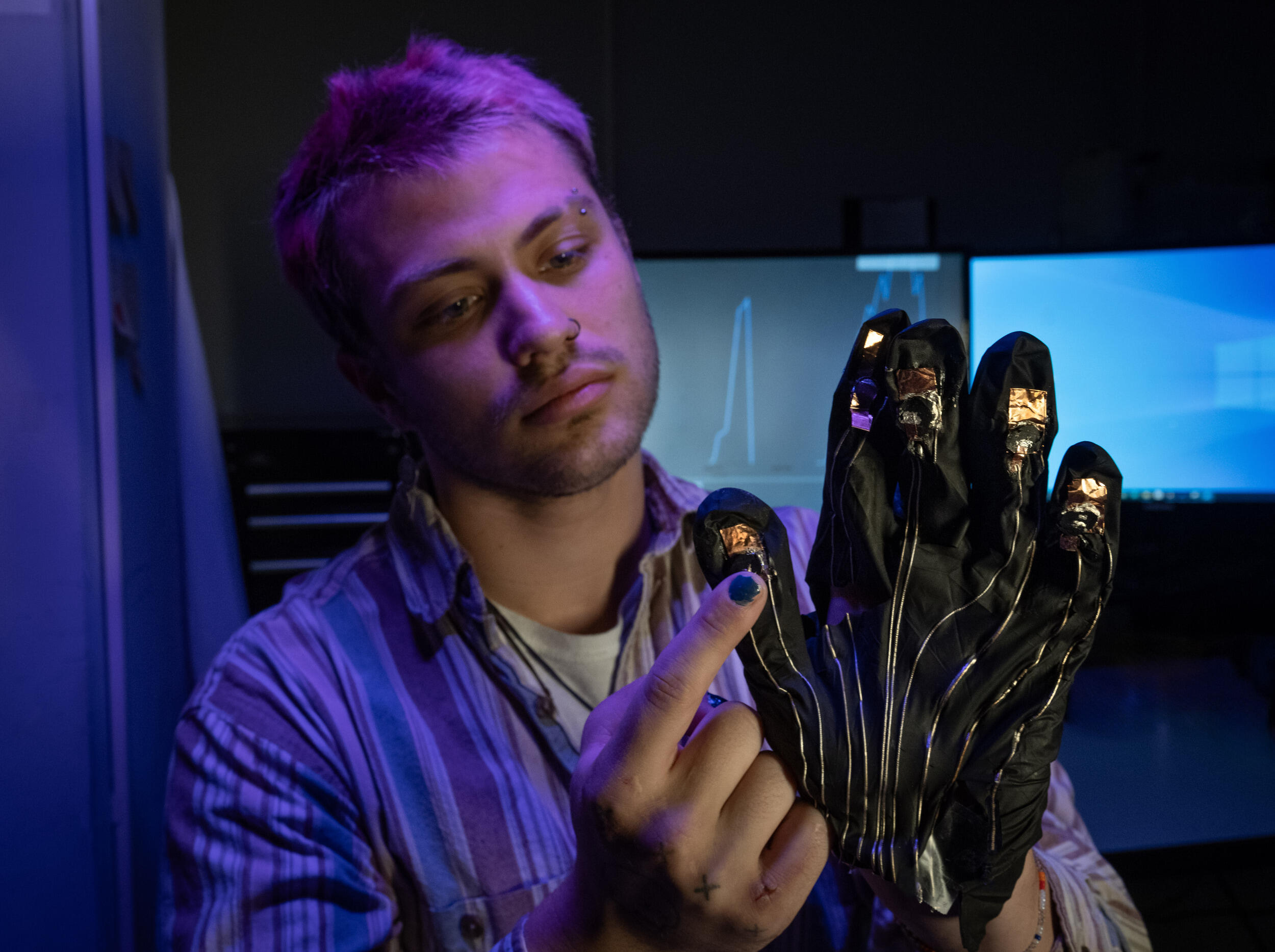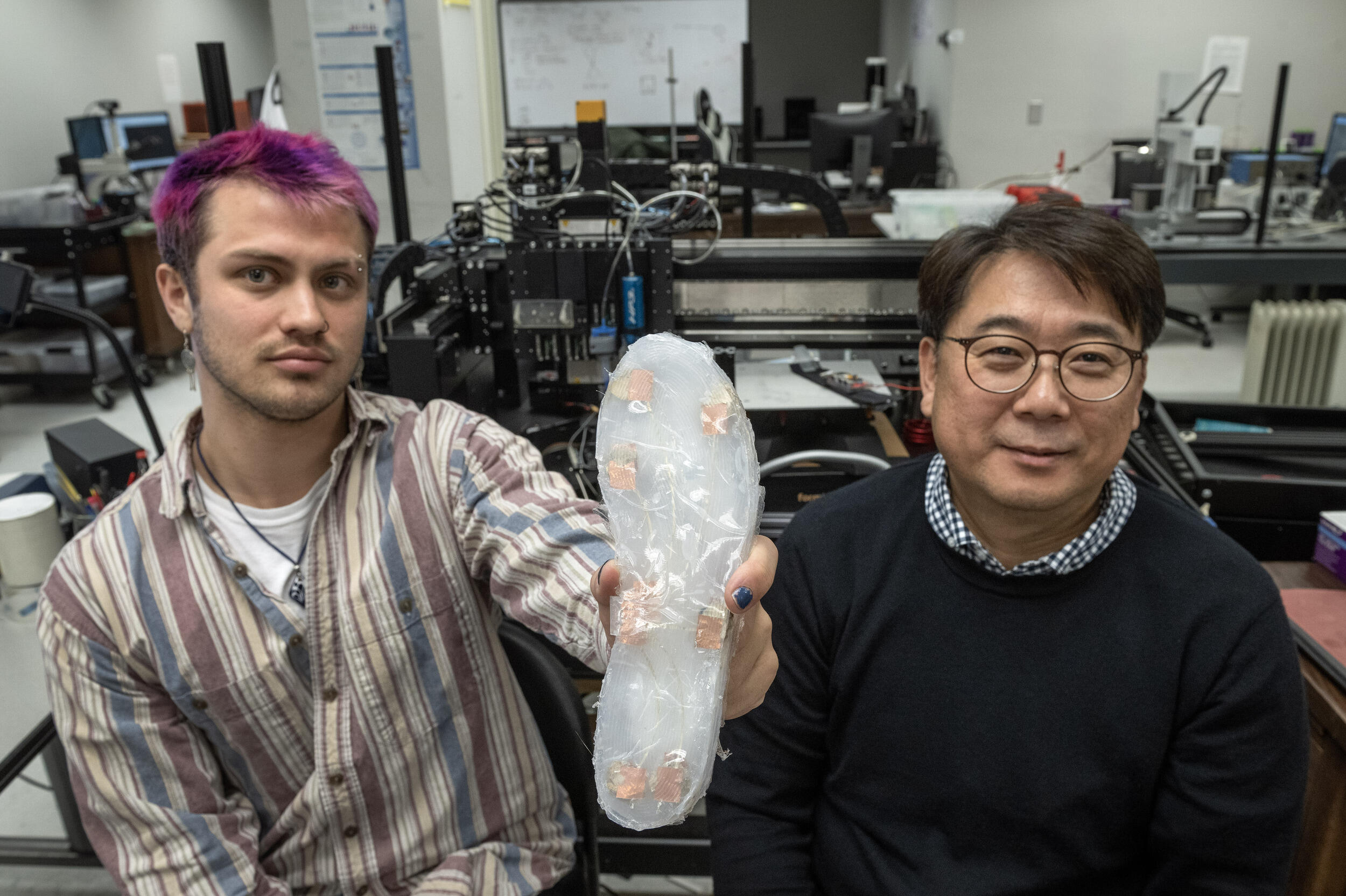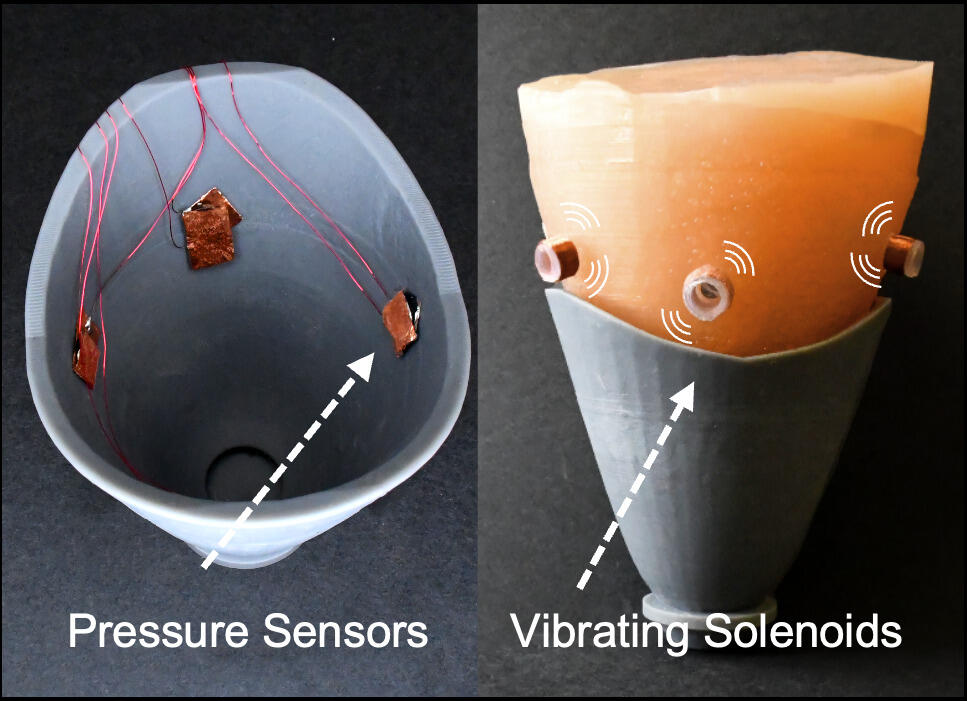
Feb. 12, 2025
From fingers to toes, wearable and vibrating technology from VCU inventors could help Parkinson’s patients and others
Share this story
Fingernail-sized vibrating gadgets, similar to the tiny devices that make your cellphone buzz, could help people with Parkinson’s disease navigate the world with more confidence and ease. The vibrating devices, which may also help people with other mobility conditions, form the backbone of new flexible, wearable technology developed by Virginia Commonwealth University researchers.
The technology, described in January in Biosensors & Bioelectronics, includes a glove and a 3D-printed shoe sole designed for people with Parkinson’s, as well as an adaptation for prosthetic leg users. Coupled with pressure sensors and paired through Bluetooth wireless connection, the vibrating devices could help address “freezing of gait,” which is one of the hallmarks of Parkinson’s.
“There’s this feedback loop between the central nervous system and the peripheral nervous system,” which includes all nerves outside of the brain and spinal cord, said Phillip Glass, the study’s first author and a Ph.D. candidate in the Department of Physics in the College of Humanities and Sciences. “The brain is constantly talking to the peripheral nervous system, including the sensors in the fingertips and feet.”
But Parkinson’s damages the link between the brain and the peripheral nervous sytem, disrupting that feedback loop. One consequence of that disruption is that almost 60% of people with Parkinson’s experience freezing of gait, finding themselves suddenly unable to lift their feet off the ground to walk.
Glass and his colleagues in the Department of Physics as well as VCU’s School of Nursing are developing wearable, vibrating technology to restore that feedback loop. The new technology could help Parkinson’s patients, as well as people with other peripheral nervous system impairments, improve their gait, balance and motor skills.
Making life easier for patients
Earlier research by Ingrid Pretzer-Aboff, Ph.D., one of the new study’s co-authors and a professor in the School of Nursing, focused on how vibrations can help Parkinson’s patients regain motor control, though the exact neurological mechanism for the effect is unknown.
“I work with patients to make their lives easier,” she said. “And in this case, to walk easier.”
While Pretzer-Aboff has previously worked with outside partners to create wearable, vibrating prototypes for Parkinson’s patients, the goal of the latest project is to develop more flexible, comfortable products through 3D printing, and to use many small vibration devices instead of one or two large, commercially available models.

“Patients felt that the old vibrators were bulky, heavy and not comfortable,” said Daeha Joung, Ph.D., an assistant professor of physics and the study’s senior author. “Patients want to have something subtle, flexible and small.”
Each wearable device operates through a simple feedback loop: When users take a step or grip an object, they apply pressure to 3D-printed sensors made of miniscule carbon nanotubes on their shoe sole or glove. Those pressure sensors then send an electrical signal to nearby vibration devices called solenoids, which are made of flexible, 3D-printed cylinders wrapped in copper wire. The electrical signal, pulsing through the copper wire, causes a magnet within the solenoid to vibrate at around the same intensity as a cellphone. Those vibrating cylinders, worn on a different part of the body, then alert the user to the increase in pressure.
The setup varies for each wearable device. When users take a step on the shoe sole, they apply pressure to sensors on the bottom of the sole, which relays a vibration to the top of the foot. When glove users grip an object, they trigger vibration on a glove worn on the other hand via a Bluetooth signal.
While those vibrations physically cue wearers to the change in pressure, they may also have a deeper neurosensory impact.
“It could be that if it vibrates, the patient knows, OK, I’m having trouble walking, so I’ll take bigger steps, slow down or turn a different direction,” Pretzer-Aboff said. “If it’s having a neurostimulation effect, it could be that it’s really activating the receptors in the skin and traveling up to the brain, and then alerting the patient to what they’re doing.”
An adaptable, versatile solution
Although the shoe sole and glove were designed for Parkinson’s patients, people who wear prosthetics may also benefit. For example, Glass and Joung’s prosthetic leg prototype may help patients sense balance or pressure issues before they become dangerous and lead to a fall, by sending a signal directly to vibration devices on the user’s upper leg.
The rechargeable, battery-powered setup is also pressure-sensitive and adjustable: More pressure on the sensors creates a stronger vibration, and the amplitude and frequency of the vibration can be customized for each user or application.

The same technology could be adapted for users with other types of peripheral nervous system dysfunction — and for broader realms, said Brent Fagg, the assistant director for innovation at VCU TechTransfer and Ventures, which helps commercialize university inventions.
“The solenoid system’s design and functionality make it versatile for numerous applications,” Fagg said. “For example, in professional athletic training gear, it could provide real-time feedback, allowing athletes to adjust their performance on the spot.”
The researchers are working with TechTransfers and Ventures to obtain a patent for their work, and they envision moving beyond prototypes into wearable, marketable products. For now, they hope to work with Parkinson’s patients from VCU Health.
“We tried to understand what the problem was, and we tried to resolve the problem,” Joung said. “How can we, as a scientist or engineer, contribute to help the patients?”
A VCU College of Humanities and Sciences Seed Award funded this project, which was also completed with the help of assistant professor of physics Richard Inho Joh, Ph.D.; undergraduate student researchers Daniel Rhoades and Gabriel Bohannon; and Sung Hyun Park, Ph.D., of the Korea Institute of Industrial Technology.
Subscribe to VCU News
Subscribe to VCU News at newsletter.vcu.edu and receive a selection of stories, videos, photos, news clips and event listings in your inbox.










